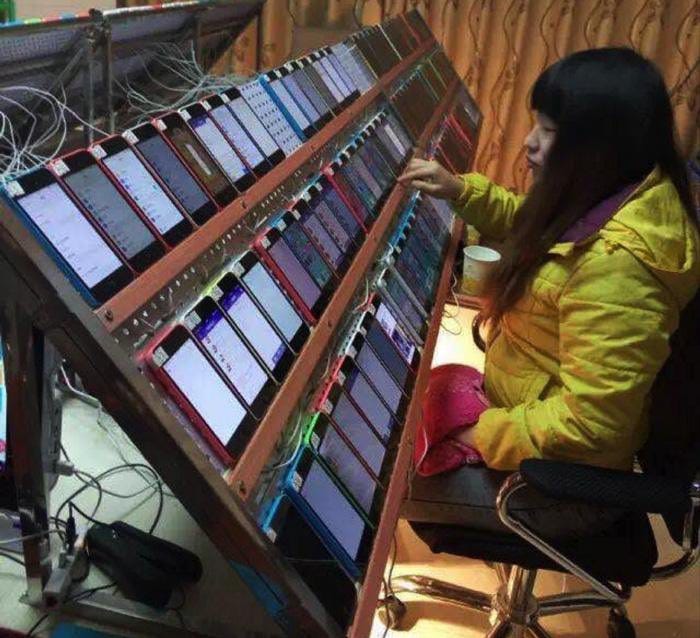There are countries where the low cost of labor makes operating phone farms a profitable endeavor. That linked VICE article is about Americans doing it. You can’t make a living with it, but you can make a fixed income bearable, or fund a fab college lifestyle.
And you can absolutely use stuff like this to create the perception of the existence of groups of humans with similar views. Or make opposing groups and have them fight. This is similar to what we saw in Meliorator Social Botnet, but it’s accessible in ways systems like that are not.
I’ve had these four screen shots since early spring - they show the progression of phone farming at scale.
The first generation was like this - people going from screen to screen on discrete phones.
The next generation of system looked like this - still racks of phones but cabled to a workstation, and there was more automation to it.
Now you can buy Android based boards and place them in a high density chassis.
The workstation setup is similar, but densities can be much higher, as the boards pack tighter while still cooling efficiently. I think these are cell phone crypto mining systems that have been modified to do more than just hashing for crypto.
This is where I have to pull out the Stages of the Simulacra slide again.
Phone farms are firmly stage three - one actual person, posing as hundreds, raking in ad fraud money and providing a facsimile of a group of people with diverse needs, wants, and opinions.
Antisocial Media providers use the KPIs (key performance indicators) of counting new users and the counting those who are active. They have to make some effort to tamp down automated activity, but they’re only motivated to do that to the point they can say they are. The actual automated activity is fine with them, so long as it’s plausibly human.
Implications:
All of this automation and fakery is going to backfire. Most people will withdraw from spaces that are overrun with this sort of thing, leaving only the bipolar, OCD, social media addicts, and others who simply can not break away. I don’t use Twitter any more, nor any of the other legion of Antisocial Media environments.
What do I use to establish and maintain my position in the online world?
I can’t control who reads here, but Substack lets me immediately eject anyone who behaves badly.
LinkedIn’s interface has been various iterations of shitty since Microsoft bought it, but I’m picky about connections and relatively sure most of mine are human. I proactively ban any swivel eyed Trump loons I see commenting on stuff, so despite having a few associates who live for the fight, it doesn’t affect me.
I just recently revived an eighteen year old DailyKos account, after thirteen years of absence, and changed its name to nealr. I also created a Democratic Undergound account, also named nealr. Like LinkedIn, these are human-centric systems that quickly punish automation and other nuisance behavior.
There’s an eleven year old nrauhauser Reddit account that’s mine. Every once in a while I feel the need to weigh in on various threads, but mostly it’s for tech support. Much like Twitter, I have a “daily driver” account that never says anything.
And there are precisely none of these facets that I truly need, if they start raising my blood pressure, I’d hit eject and not look back.
Conclusion:
Look at your environment. Do you see any place where automation might be in effect? Can you simply cut those virtual places out of your life? If not, start thinking about alternatives you could use … you’ll feel much better just by starting to look.
This is part of what is covered in Paranoia: Pathological Or Professional? If you start being mindful of certain things, and think you’re seeing it, that’s good … until it starts creeping you out. Then your choices are to look away, if it’s an environment that demands your attention, or just run away if it’s a negligible loss.








